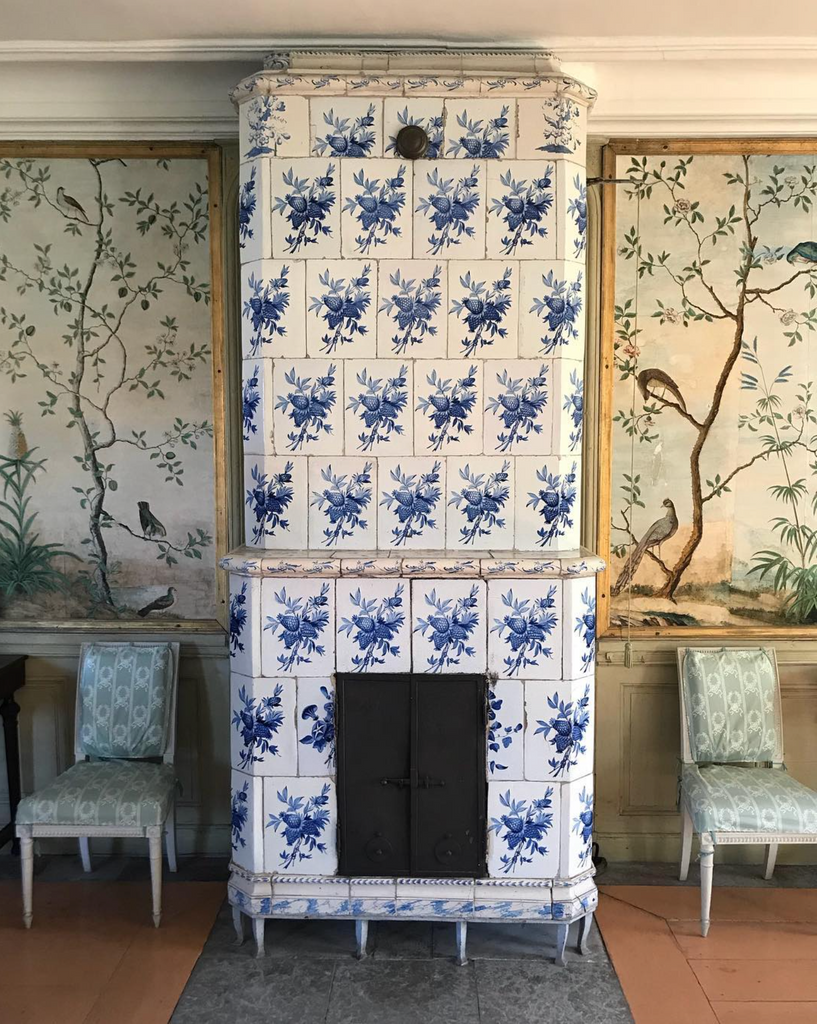There’s something magical about being in Sweden at this time of the year. When the sun rises in the morning it bathes the snow-covered landscape in a pink light that is nothing short of dreamy. There are blocks of ice floating in the bays in Stockholm, and because it gets dark shortly after lunch, towns light up early like winter wonderlands. A toasty counterpoint to this frigid charm is the traditional tiled Swedish stove. Called a kakelugn (KAH-kel-oon), they were once ubiquitous in Swedish houses and something interior designer Beata Heuman remembers so fondly from her childhood in Sweden, she has designed a replica that’s on display in her new London showroom.

Heuman’s kakelugn is actually a rounded cabinet modeled after the traditional 18th century tiled stove. “The curves of the main body are made from birch plywood, with solid wood feet, plinth, mouldings, and capping. Once constructed, we commissioned specialist painters to trick the eye into believing it’s tiled with splattered ceramic tiles,” she says. She consulted on its design with her aunt, a Byggnadsantikvarie (building antiquarian), to get the proportions and hierarchy of tiles right and it’s available to order with a lead time of 16 weeks.
The original kakelugn, invented in 1767 by architect Carl Johan Cronstedt and general Fabian Wrede, was constructed of bricks clad with tile and boasted a small, enclosed firebox with several flues. It was dramatically more efficient at retaining heat than the wood burning stoves of the time, and as a result, transformed the way people were able to live in their homes during the winter months. At first a luxury afforded only by the elite, tiles could feature ornate reliefs or be hand-painted, often with floral motifs, and their styles tended to follow the fashions of the time.
In the mid-18th century, two factories, Marieberg and Rörstrand, were the most well-known, producing delightful Rococo examples through a distinctly restrained Swedish lens. The kakelugnar (tile stoves) at Sturehov, left, are particularly fine examples as the castle was the home of Marieberg’s owner, Baron Johan Liljencrantz, during the factory’s heyday. At King Gustav’s Gripsholm Castle, Gustavian examples naturally dot nearly every room. And Neo-Classical references, which became popular following the excavation of Pompeii, can be seen at Almare-Staket, a manor house north of Stockholm that’s been in the same family since the late 18th century. It’s available for private hire these days, as is Van der Nootska Palace, where Campbell Rey’s 2021 rug collaboration with Nordic Knots was photographed in front of a blue and white floral kakelugn.
When Balineum’s founder Sarah Watson visited Sweden, Svindersvik, centre, was on Heuman’s must visit list for her. The 18th century summer house, which is now owned by the Nordic Museum of Stockholm, is a delightful reflection of these trends: the main house was built in the 1740s in the Rococo style, in the 1780s a pavilion was added in the Gustavian style, and also boasted elements of the then burgeoning Neo-Classical style. There are multiple kakelugnar on display, including a cylindrical tiled stove tucked into an alcove on one side of a door, flanked by a wooden replica in an identical alcove opposite. You can achieve an equally symmetrical look by commissioning one of Heauman’s cabinets to sit opposite a kakelugn in your own project.
Lindholm Kakelgnar sells antique Swedish stoves from the 18th century through the early 20th century. Beyond Marieberg and Rörstrand, look for tiled examples by original manufacturers like Rudholms, P.H Lundgrens, and Karlskrona. Or try Gysinge’s newly made stove in the 18th century style. It’s truly a unique Swedish creation, made using traditional methods with the tiles produced in Southern Sweden, the hardware foraged by a blacksmith near Stockholm, and the flagship two hours north in Gysinge, where the stoves are displayed in an old worker’s housing. It’s well-worth a visit though there is a smaller showroom in Stockholm itself. Alternatively, for a 21st century take on the kakelugnar, try Gabriel whose tiled stoves are handmade on the Baltic coast in Timmernabben and can be customised with bespoke colours and various other details of your specification. Examples are on display in the showroom there and factory tours are available on request. They also sell locally in the UK through The Ceramic Stove Company in Oxford which counts designers Adam Bray, Henri Fitzwilliam-Lay and Retrouvius among its clients. Regardless of which stove you choose, do as Soane and Olivia Outred have done, and hire Stovemason to put it together for you.
But do try to get over to Sweden for inspiration at the very least. December is such a wonderful to be there. Stay at the recently expanded Ett Hem hotel, right, famously designed by Ilse Crawford who worked on the new addition as well. There are examples of both painted kakelugnar and those with relief tiles in the public spaces so you can experience firsthand how comforting they are. The tiles, it should be noted, do not get hot to the touch. Then be sure to visit Skansen, Stockholm's open-air museum made up of buildings from the 14th-20th centuries. There are glazed tiled stoves of course and it’s bursting with charm this month, from holiday concerts to their legendary Christmas market.
Lastly, if you’re interested in learning more about tiled Swedish stoves—there is so much more we couldn't get to here—scoop up some of these books: Carl Frängsmyr’s Kakelugnen I Sverige (The Tile Oven in Sweden); Susanna Scherman’s The Swedish Country House and Den Svenska Kakelugn (Swedish Tiled Stoves); and Lars and Ursula Sjöberg’s The Swedish Room.
Photos: Sturehov by Michael Perlmutter, from Den Svenska Kakelugn; Svindersvik by Sarah Watson; Ett Hem hotel courtesy of Ett Hem Stockholm.

